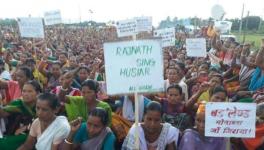Is the Modi Government Misleading Parliament by Cherry-Picking Data?
Image for representational use only; Image Courtesy : NDTV
Since its early days in the beginning of the last decade, the Narendra Modi government in Gujarat was in the news for data manipulation, something that various researchers, economists and writers have pointed out time and again. For example, the are well-documented instances of the way the Modi government manipulated data related to Vibrant Gujarat summits. When he became Prime Minister, many researchers and others who analyse government data, feared that the same would happen at the Centre. Their fears were not unfounded. Questions over the recently released GDP back series data, doing away with employment data, no record of data on farmer suicides and releasing the approved number of beneficiaries as the final data to create a hype about his ‘good governance’ have been raised quite often. In this, the most interesting thing his Ministers use to mislead the public is cherry-picking of data. The latest example is an answer by the Minister of State for External Affairs Affairs’ to Unstarred Question No: 1726in Rajya Sabha.
Rajya Sabha MP Dr Sanjay Sinh asked the Minister of External Affairs to state (a) the details of official foreign tours of Dr. Manmohan Singh during 2009 to 2014 and Shri Narendra Modi since 2014, till date; (b) the purpose and total expenditure on each journey together with the names and designation of the persons, official and non-official, who accompanied both the Prime Ministers during their foreign tours; and (c) the details of investment received from the countries visited by the current Prime Minister?
In his detailed 35-page-long reply, MoS, External Affairs, Gen. (Dr) V K Singh (Retd), informed Parliament that all the trips of PMs since 2009 were covered and all the officials and journalists who travelled with both PMs were also covered in detail. In annexure IV, the answer also explains the inflow of foreign direct investments received by the countries visited by Prime Minister Modi.
As per the annexure, titled “Cumulative FDI inflows and FPI/FII investment in India between 2014 and 2018”, FDI grew from $30,930.5 million in 2014, to $43,478.27 million in 2017. The cumulative FDI inflows between 2014 and June 2018 stood at $136,077.75 million, compared with $ 81,843.71 million recorded cumulatively for the years between 2011 and 2014. “As a result, the total FDI received in the country has gone up by 67% in a short span of three years. Maximum FDI inflows were recorded in sectors such as metallurgical industries, power, electrical equipment, computer software and hardware, telecommunications, Information and Broadcasting, automobile, chemicals and fertilisers, drugs and pharmaceuticals, services sector (including Finance, Banking, Insurance, Non-Fin/Business, Outsourcing, R&D, Courier, Technology, Testing and Analysis, et al), tourism, and construction. Between 2014 and 2017, the cumulative FII Equity investment in India figured at INR 496,845 crore.”
There are a few problems with this answer. First, the Modi government is comparing their four-year FDI inflow numbers with the previous UPA government’s three-year data. i.e. 2011-14 with 2014-18 to give a numerical advantage to themselves.
The Department of Industrial Policy &Promotion (DIPP) has been releasing periodical data on FDI. As per DIPP data, the cumulative FDI inflow to India from March 2010 to March 2014 stands at $103,226 million. Hence, FDI inflow did not go up by 67%, as claimed by the government, but only by 32%. So, when Modi the government gives a comparison, the usage of data must be of an equal time period. This does not show that the Modi government’s numbers are lower than that of UPA, instead the gap shown between the two data sets has narrowed.
If we take the year-to-year percentage of growth in FDI inflows, the highest growth was in 2006-07, when it grew 155% from 2005-06. The second best is a 53% increase from previous year in 2007-08, and the third best growth was in 2001-02, under the Atal Bihari Vajpayee government, when FDI inflow increased 52% than the previous year. In the 10 years of United Progressive Alliance rule, FDI flow increased on an average of 31.1%, while in the first four years of the Modi regime, it stands at 14.75%.
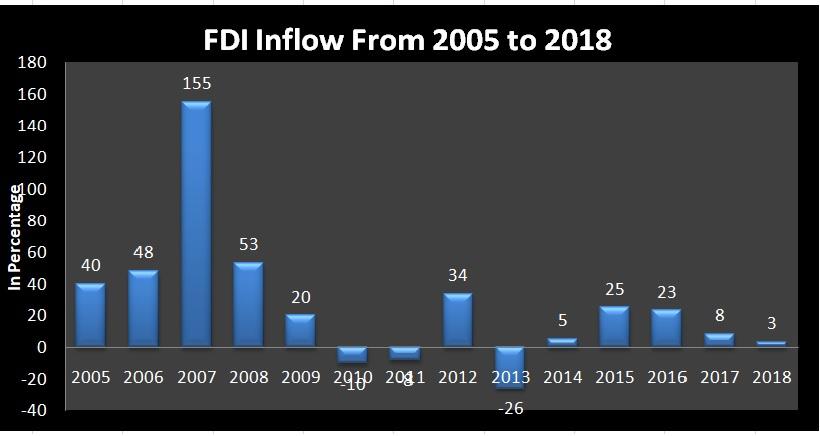
World Bank data shows, India’s FDI as percentage of GDP stood at 2% in 2016 which was the same in 2011. At its peak, it reached 3.6% in 2008.
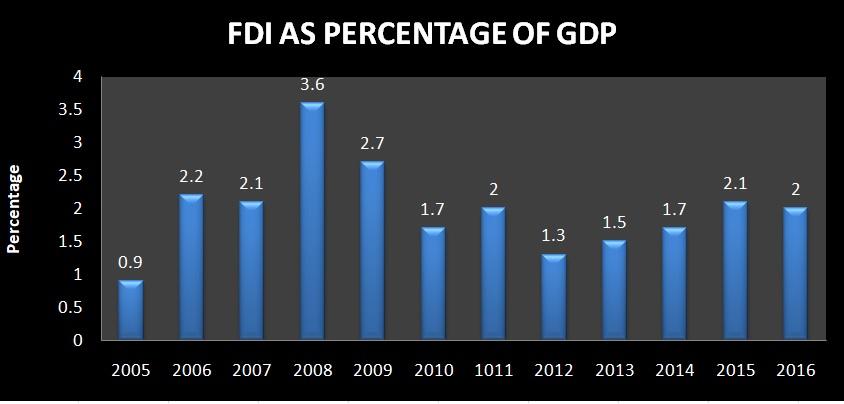
An analysis done by India Spend, based on a study paper by the Institute for Studies in Industrial Development (ISID), shows out of the $51.7 billion that came into India as FDI from October 2014 to March 2016 , only 37% went into manufacturing. The study paper points out, quoting K S Chalapati Rao, the co-author of the ISID study paper and distinguished fellow, ISID, that: “Realistic FDI represents a packaged transfer of capital, technology, management and other skills, which takes place internally within multinational firms such as Suzuki Motors that has been in India for almost 40 years now.”
IndiaSpend wrote: “Between October 2014 and March 2016, the share of RFDI was a little above 50%. Thus, there was no change in the broad character of inflows compared to the earlier years (2004-05 to 2013-14) to indicate a shift in the nature of inflows received till March 2016, the report said.” Hence, boasting about the hike in FDI is just another ploy to mislead the people.
Gen. Singh’s reply in Rajya Sabha shows a list of countries claiming these to be the top 10 from where FDI comes to India.
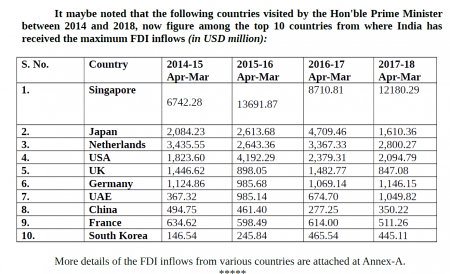
But, this is not the exact list of the top 10 countries, which raises suspicions of something being hidden. So, let us check the actual list of the top 10 countries from where FDI came into India as per DIPP data as on March 31, 2018.
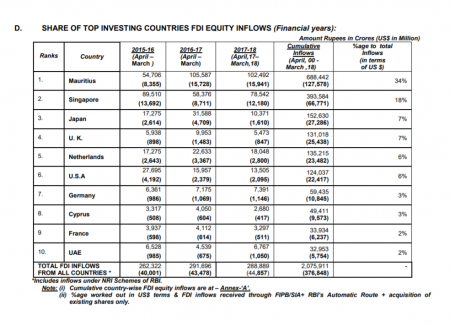
Now let us check the same list as on March 31, 2014.
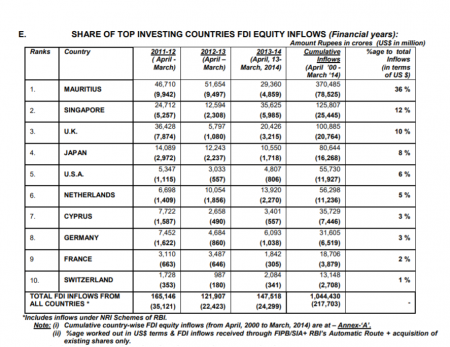
And this is how the list looked like in March 2009.
The lists show that Mauritius and Singapore topped the list of countries from where FDI flows into India came since many years. Both the countries are known tax havens. So, what the government has attempted to do in its reply to Rajya Sabha is bring down the names of the two tax havens – Mauritius and Cyprus -- and add China and South Korea to the list of the top 10 instead. This raises the question: Is the Modi government ashamed to admit that the maximum FDI is coming into the country from tax havens, especially when one of their important election promises was eradication of black money and ending corruption?
The government’s reply in Rajya Sabha says “Maximum FDI inflows were recorded in sectors such as metallurgical industries, power, electrical equipment, computer software and hardware, telecommunications, Information and Broadcasting, automobile, chemicals and fertilisers, drugs and pharmaceuticals, services sector (including Finance, Banking, Insurance, Non Fin/Business, Outsourcing, R&D, Courier, Technology, Testing and Analysis, et al), tourism, and construction”. Now. We don’t know why the Minister’s reply has given in that order, since the actual sectors mentioned by DIPP here are in the exact order.
This is just one example to point out how the Modi government is cherry- picking data to project their performance as better than previous governments. And to prove their point, the government is misleading Parliament with impunity.
(Ravi Nair broke the story of the Rafale scam and is writing a book on the subject. The views expressed are personal.)
Get the latest reports & analysis with people's perspective on Protests, movements & deep analytical videos, discussions of the current affairs in your Telegram app. Subscribe to NewsClick's Telegram channel & get Real-Time updates on stories, as they get published on our website.










